Please Take Note: This is a review of the final game, but it might change slightly based on the success of the Kickstarter campaign. The game is being reviewed on the components and the rules provided with the understanding that “what you see is not what you might get” when the game is published. If you like what you read and want to learn more, we encourage you to visit the game’s web page or visit the Kickstarter campaign. Now that we have all that disclaimer junk out of the way, on with the review!

The Basics:
- For ages 9 and up (publisher suggests 10+)
- For 2 to 5 players
- Variable game length
Geek Skills:
- Active Listening & Communication
- Counting & Math
- Logical & Critical Decision Making
- Reading
- Pattern/Color Matching
- Strategy & Tactics
- Risk vs. Reward
- Hand/Resource Management
- Bidding
- Worker Placement (obviously)
Learning Curve:
- Child – Moderate
- Adult – Easy
Theme & Narrative:
- Gather the best workers and train them in order to claim the most lucrative jobs!
Endorsements:
- Gamer Geek approved!
- Parent Geek approved!
- Child Geek approved!
Overview
You consider yourself an optimistic opportunist. That’s why when the economy took a hit, and lots of highly skilled individuals were out of work, you saw nothing but profit to be gained. You have started your own Temp Business and are now seeking to fulfill lucrative contracts. Of course, so are other entrepreneurs, but a little competition can be healthy, right? Train your employees well and you just might be able to beat your competition to the finish line!
Worker Placement, designed by Mark C. MacKinnon and to be published by Dyskami Publishing Company, will reportedly be comprised of 1 game board, 62 Business cards (20 Worker, 26 Skill, and 16 Management), 42 Job cards, 5 Player Order cards, 60 Skill cubes (15 red Clerical, 15 yellow Labour, 15 black Tech, and 15 green Life), 25 Player tokens (in 5 different colors, 15 Employee Worker tokens (i.e. “meeples”), 5 Cash tokens, and 5 Thumb tokens) and 1 Hourglass token. As this is a review of a prepublished game, we will not comment on the game component quality. I should also note that I was not given the full game for this review and the game itself is positioned for future expansions that are not yet available. In short, what I was provided doesn’t even come close to representing what Worker Placement will be when it’s published, but I was given enough to play the game fully.
Game Set Up
To set up the game, first place the game board in the middle of the playing area.
Second, sort the Skill cubes into 4 different colors and place them to one side of the game board in separate piles. This is the Skill cube supply for the game. I suggest you use small cups to hold each color set to help keep your playing area tidy.
Third, place the Hourglass token on the “round 1” space found on the game board’s Time track.
Fourth, take the Player Order cards and remove any numbered cards that exceed the number of players in the game. For example, if playing with 3 players, you would remove the “4” and the “5” Player Order cards and keep the “1”, “2”, and “3” Player Order cards. The removed Player Order cards are out for the duration of the game. Place the remaining Player Order cards to one side of the game playing area.
Fifth, shuffle the Business cards and deal 4 to each player, face-down. Players should look at their cards, but keep them hidden from their opponents at all times. The remaining Business cards should be placed, face-down, on the Business card draw pile space found on the game board.
Sixth, shuffle the Job cards and place them, face-down, on the Job card draw pile space found on the game board.
Seventh, have each player select a color of their choice. Each player then takes the 3 meeples, 1 Cash token, and 1 Thumb token that matches their color. The 3 meeples should be placed in front of the player. This area in front of the player is referred to as the “Reserve Area” for the duration of the game. Each player should also place their Cash token on the “$2” space on the Cash track and the Thumb token on the “2” space of the Thumbs track found on the game board.
Seventh, the players should now collectively decide and agree upon the number of rounds that will be played. A standard game consists of 8 rounds. For a shorter game, players should elect to play 5 rounds. For a longer game, players should elect to play 12 rounds.
This completes the game set up. When done, your playing area might look like the following example.
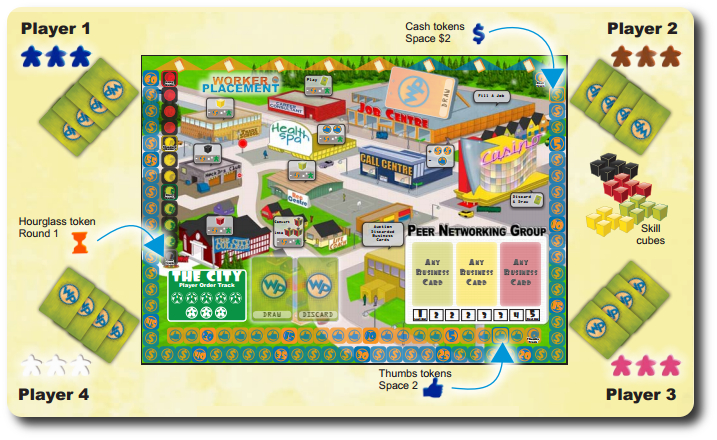
Time to make some money!
The Work Week
Worker Placement is played in rounds with the number of rounds per game set by the players during the game set up. Each round consists of 6 specific actions taken by all the players. A single round of game play is summarized here.
Action 1: Determine Player Order
Shuffle the Player Order cards and deal 1 out to each player. The Player Order cards have a number value that ranges from 1 to the total number of players at the table. Each player takes the number on their Player Order card and adds to it the value their Thumb token currently occupies on the Thumbs track. For example, if a player was given a Player Order card with the number value of “4” and their Thumb token was currently on the “5” space on the Thumbs track, their Player Order value would be “9”.
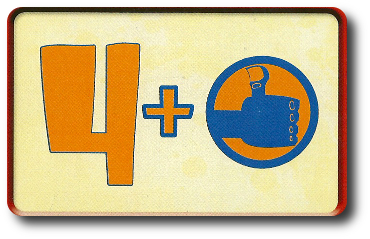
Starting with the player with the highest Player Order value, each player now places 1 of their meeples on the Player Order track starting with the first position, then the second position, and so on until every player has placed 1 meeple. Ties are broken by player Thumbs track position, with the tie going to the player who has a higher Thumbs track value.
Set the Player Order cards to one side of the playing area after this action has been completed by all the players.
Action 2: Reveal New Jobs
For the first round of the game, deal a minimum of 4 Job cards and place them face-up above the game board. If there are more than 4 players in the game, deal 1 Job card per player. The Job cards represent the currently available job openings that the players will want to collect and fulfill. After the Job cards have been dealt and revealed, flip over the top most Job card on the Job deck. This is a “sneak peek” of what will be coming up during the next round, but cannot be claimed during the current round.
For the second and subsequent rounds, any Job cards not fulfilled by the players from the previous round remain available. The number of new Job cards dealt will depend on how many Job cards were taken during the previous round. For example, if a total of 5 Job cards were dealt for the first round, and 3 were taken, the second round would require only 3 new Job cards to be revealed and placed for a maximum of 5 cards. Again, after the Job cards have been dealt and revealed, flip over the top most Job card on the Job deck.
Note that once the Job card draw deck is depleted, no additional jobs are dealt. If such is the case, this action can be skipped for the duration of the game.
Action 3: Draft Business Cards
Deal 3 Business cards to each player, face-down, starting with the player in first position on the Player Order track. Each player now views their 3 Business cards and selects 1 to add to their hand. From the remaining 2 Business cards, the player will select 1 to give to their opponent on their left (which their opponent adds to their hand) and 1 that will be placed face-down on the “Peer Networking Group” building found on the game board.
There are 3 different types of Business cards. These are “Worker”, “Management”, and “Skill” Business cards.
- The “Worker” Business cards represent individuals who work for the player’s Temp Business. These individuals provide specific Skill cubes and are used to claim Job cards.
- The “Management” Business cards are a one time action or bonus the player can use during the game in an attempt to get ahead of their competition.
- The “Skill” Business cards represent a specific Skill type of the color shown and are used like a Skill cube.

From left to right: “Worker”, “Management”, and “Skill” Business cards
Note that if the Business card draw deck is depleted, the Business card discard pile should be shuffled to create a new Business card draw deck.
Action 4: Auction Discarded Business Cards
The Business cards that were placed in the ” Peer Networking Group” building during “Action 3: Draft Business Cards” are now collected and shuffled. Three are selected at random and placed face-up, one in each of the 3 card spaces available in the “Peer Networking Group” building. Any remaining Business cards are discarded.
Starting with the player in first position on the Player Order track, each player takes turns placing 1 of their meeples from their Reserve Area to the Bidding track below the “Peer Networking Group” building space. The numbers (ranging from 1 to 5) identify how much Cash the player is willing to pay to grab one of the Business cards. If a player wants to bid, they put their meeple on any unoccupied space on the Bidding track. A player can also pass. Any previously played meeples must remain on the Bidding track, however. After all the players have had a chance to bid or pass, a second round of bidding then starts with the players using their second meeple from their Reserve Area. Players cannot bid a specific value if they cannot pay for it!
After the bidding ends, the player with the meeple in the highest position takes any Business card of their choice from the “Peer Networking Group” building. The player with the second highest then takes their choice of the 2 remaining Business cards, with the third highest taking the remaining Business card. The Business cards are placed in the player’s hand and each player now adjusts their Cash token by moving it backwards a number of spaces equal to their bid value. Any player who did not claim a card leaves their Cash token where it is.
All the players now take their meeples back and place them in their Reserve Area.
Action 5: Place Workers
Starting with the player in first position on the Player Order track, each player takes turns placing their meeples (their “workers”) from their Reserve Area to the buildings on the game board, one meeple at a time per turn. The only building that cannot be used is the “Peer Networking Group”. When the meeple is placed, the player immediately moves their Cash token 1 space back for every meeple that occupies the building. For example, if the player’s meeple is the 3rd to occupy the building, they would move their Cash token 3 spaces back. Players do not move their Cash token if they are the first to occupy the building. Nor do they move their Cash token if they place their meeple in the “Call Center”, the “Casino”, or the “Job Centre” buildings. These buildings can hold unlimited meeples and cost nothing.
The first two meeples the player will use are those in their Reserve Area. The third meeple they will place will come from the game board’s Player Order track. The only restriction when placing a meeple is that the player must be able to take the action or use the benefit that is associated with the building. In other words, the player cannot simply occupy the building. A brief description of the buildings follow:
- The City College: This building allows the player to take 1 red Clerical Skill cube from the supply and add it to their Reserve Area.
- Rec Centre: This building allows the player to take 1 green Life Skill cube from the supply and add it to their Reserve Area.
- Trade School: This building allows the player to take 1 yellow Labour Skill cube from the supply and add it to their Reserve area.
- Hackers Club: This building allows the player to take 1 blue Tech Skill cube from the supply and add it to their Reserve Area.
- Life Coach: This building allows the player to exchange 1 Skill cube (of any color) from their Reserve Area for any 2 Skill cubes of the player’s choice from the supply. The exchanged Skill cube is placed back in the supply area.
- Health Spa: This building allows the player to immediately advance their Thumb token 2 spaces on the Thumbs track.
- Job Centre: This building allows the player to fulfill and claim 1 Job card located at the top of the game board. See “Claiming Jobs” for additional details.
- Call Centre: This building allows the player to immediately advance their Cash token 2 spaces on the Cash track, but their Thumb token goes back 1 space on the Thumbs track. This building does not cost Cash to use (unlimited meeple placement).
- Peer Networking Building: This building allows player to bid and claim the Business cards that were placed face-down during “Action 3: Draft Business Cards“. It’s not used during this action.
- Career Consultants: This building allows the player to play 1 “Management” Business card from their hand. The player then takes the action noted on the “Management” Business card.
- Casino: This building allows the player to discard any number of Business cards from their hand. For every 1 Business card discarded, the player can draw 1 new Business card. This building does not cost Cash to use (unlimited meeple placement).
This action is completed once all the players have placed all 3 of their meeples and resolved any building actions or cards played.
Action 6: Reset
The final action also marks the end of the round. Every player collects their meeples from the game board and sets them back in their Reserve Area, the Hourglass token is advanced 1 position, and players must now discard down to no more than 5 cards in their hand.
If this was the end of the final round (as determined by the players during the game set up), the game now comes to a close and the winner is determined. If not, a new round now begins starting with action 1 noted above.
Claiming Jobs
During “Action 5: Place Workers”, players can place their meeples on the “Job Centre” building on the game board. Each Job card lists requirements and benefits gained from the job being offered, but before they can claim a Job card they must have at least 1 “Worker” Business card in their hand.
- Job Title: The name of the job being offered (no impact to game play).
- Required Skill Cubes: This shows the number and color of Skill cubes the player must provide before they can claim the Job card with a “Worker” Business card. The player pays using any Skill cubes from their Reserve Area, any Skills their selected “Worker” Business card provides, and any “Skill” Business cards the player has in their hand. Any used “Skill” Business cards are discarded and any used Skill cubes from the Reserve Area are returned to the supply. The “Worker” Business card used to claim the Job card need not provide or even have a required Skill cube color, but it certainly is less expensive for the player if they do.
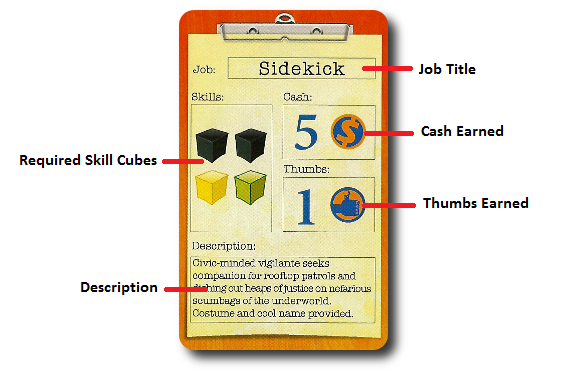
- Cash Earned: This lists how many spaces the player advances their Cash token on the Cash track if they can claim the Job card.
- Thumbs Earned: This lists how many spaces the player advances their Thumb token on the Thumbs track if they can claim the Job card.
- Description: This explains what the job entails (no impact to game play).
Claimed Job cards are placed in front of the player. A player is welcome to attempt to claim as many Job cards as they can afford during this action, but they cannot place their meeple on the “Job Centre” building unless they know for certain they can claim a Job card.
A few examples of the jobs available include (but are not limited to):
- Genius Billionaire Playboy Philanthropist
- Paint Drying Monitor
- Gladiator
- Board Game Designer
Note that my copy of the game had a “Meth Cook” Job card (yes, Meth, the drug). All the Parent Geeks voted to remove that card when playing with the Child Geeks and with their peers. That was the only “questionable” Job card included in the game. I go into more detail regarding this Job card in my Final Word section of this review.
The Weekend
At the end of the final round, the winner of the game is determined.
- The player or players (if tied) with the highest Thumb value on the Thumbs track moves their Cash token a number of spaces forward equal to the number of players in the game. For example, if the player has the highest Thumb value in a game with 3 players, they would move their Cash token 3 spaces forward on the Cash track.
- Each player is given 1 Cash bonus for every 2 unused Skill cubes of any color remaining in their Reserve Area. For example, if a player had 5 unused Skill cubes in their Reserve Area at the end of the game, they would move their Cash token 2 spaces forward on the Cash track.
- Any Cash bonuses provided by the cards in the player’s hand are now revealed and the player’s Cash token placement is adjusted accordingly.
The player with the highest Cash value on the Cash track is the winner. Ties are broken by player’s Thumb token positions on the Thumbs track.
Game Variants
- In a 2-player game, deal 1 additional Business card to the “Peer Networking Group” building found on the game board during “Action 3: Draft Business Cards”. There should always be a minimum of 3 Business cards located in the “Peer Networking Group” building at the end of this action.
- During “Action 3: Draft Business Cards”, players can elect to pass different directions each round instead of always passing left. For example, players could pass left during the first round, to the right during the second, and across the table during the third round.
To learn more about Worker Placement and read the full rules, visit the game’s web page or visit the Kickstarter campaign.
Prediction
Worker Placement appears to be a light Eurogame. Resource management and worker placement (*snicker*) is a must, but the game play appears to be very casual. The sequential actions during a round are easy to understand and the number of choices a player needs to make appear to be manageable. I think the game will do very well with the Gamer Geeks and with the Parent Geeks, but I’m not certain how well it will be received by the Child Geeks. We’ve played other Eurogames in the past with the Child Geeks with mixed to negative results (Viticulture is a good example). For the most part, the Child Geeks understand how to play the games because they are structured in a logical order that is easy to follow. If, however, the game’s theme and narrative bores them or there is simply too much to consider during a single turn, the Child Geeks tend to reject it. I think the amount of thought necessary to play this game competitively is fairly light and the learning curve should be no more than moderate for the Child Geek group.
Teaching new players Worker Placement is best done by quickly going through a single round. Each game round is the same and understanding what the intent and focus of each of the actions are is essential to a player’s success. That being said, there isn’t a lot to think about during a single action, but understanding how each action is related to the other actions is crucial if the player wants to be competitive. A player will ALWAYS have something to do and to think about during each action, but the level of importance of the action will depend on what the player is attempting to complete and how well they understand the game. Any individual who has played a Eurogame in the past will have no problem understanding how to play Worker Placement after a quick summary of the actions during a single round. Expect to put a bit more effort into it for brand new players, as the game can seem overwhelming at first.
Worker Placement does require its players to read the cards in their hand and keep information secret. As such, the game cannot be played by anyone who does not know how to read. The game publisher suggests that the minimum age for the game be no older than 10-years-old, but I see no reason why my 9-year-old can’t play the game and play it well. And so, after teaching Worker Placement to my 9-year-old, I asked him what he thought of the game so far.
“Pretty simple and straight forward. I don’t really get the whole job placement thing, but the game play sounds easy enough.” ~ Liam (age 9)
My little geek makes a good point. Younger players might not understand that game’s theme and narrative, but like most Eurogames, the theme and narrative is there to add flavor to the the game play. A player need not understanding anything about the temp placement business model or how the economy works to play Worker Placement. Let’s give the game a try and see if it works well or a replacement is in order.
Final Word
The Child Geeks didn’t know what to think of the game at first. The older Child Geeks understood the Temp Business model being portrayed in the game, but the younger Child Geeks did not. Again, it’s not necessary to understand a Temp Agency’s business model to play Worker Placement, but without understanding the game’s subtle narrative, some of the Child Geeks felt like they were simply going through the motions. For a Child Geek, enjoying a game is more about what it makes you think about versus what the game is doing. Games with lots of flavor tend to attract the attention (and eye) of the Child Geeks much easier than an abstract game, regardless of how good the abstract game might be. But Worker Placement had enough concrete details to offset any abstract game mechanisms. It helped the Child Geeks when I told them to think about the game as simply getting the right workers together to claim as many jobs as possible. They should use the Skill cubes like money and claim as much as they could as fast as they could. Which, honestly, is the goal of the game. This helped them and they became more involved. When the game was over, and I asked the Child Geeks what they thought about Worker Placement, they took their time to formulate their response. The best answer came from my Child Geeks who said, “This is an easy game to learn and to play, but you have to watch what you collect and when. I liked it and would play it again, even though I don’t really get the game’s story.” All the Child Geeks voted to approve the game with mixed levels of enthusiasm about the game itself.
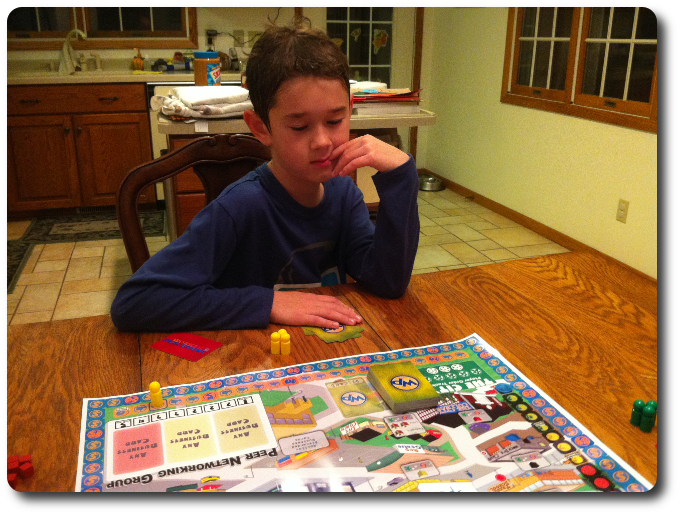
My oldest little geek listens intently as I describe how the game is played
The Parent Geeks very much enjoyed Worker Placement and thought it was a great game to play with their family and their friends. At the family gaming table, the ability to adjust the game’s length was very well received and a single game lasted just as long as everyone wanted it to. When playing the game with their peers, the game’s length was almost always standard to long. Regardless of the game’s length, non-gamers and casual gamers all enjoyed the game playing experience Worker Placement provided. According to one Parent Geek, “This is an easy game to learn how to play and to enjoy. I like how fast it played and how engaged it kept me. I’m looking forward to seeing what the final game is like.” All the Parent Geeks voted to approve the game, but highly disapproved of the “Meth Cook” Job card.
The Gamer Geeks found Worker Placement to be an entertaining, albeit light, Eurogame. According to one Gamer Geek, “I’m not seeing anything new here, but the game play is tight and well thought out. This is a solid game.” None of the Gamer Geeks had any complaints. Even the most elitists of the Gamer Geeks I sat down with thought the game was, in his words, “not bad”. None of the Gamer Geeks thought the game was terribly heavy, but would warmly welcome it on their gaming tables if it was offered. When the games were over and it came time to vote, the Gamer Geeks all agreed to approve Worker Placement.
I need to jump on my soapbox and get all preachy for a moment…
Any company that is publishing a new game with a recommended minimum age of 10-years-old should think twice before adding game components that make light of illegal drugs. Especially if the card on which the drug is referenced awards the player if they use it. The inclusion of a Meth drug maker as a viable job was one intended to be a joke, but it isn’t funny. In fact, it’s in exceedingly poor taste. Meth is a very dangerous drug. Those who make it run the risk of blowing themselves up and putting everyone around them at risk. The drug itself is highly addictive and will literally destroy you. It’s being sold to kids at schools and on playgrounds, ruining lives, and killing people. Why the Dyskami Publishing Company included a game card that awards a player for fulfilling a job that makes the drug is, in my opinion, irresponsible. CBS News released an article that shows the effects of Meth on an individual. Here’s the link to the article. Prepare to be sickened and horrified in equal measure.
I am breaking protocol here. I award any game that is approved by all three of our groups (Child, Parent, and Gamer Geeks) the Father Geek Seal of Approval, regardless of how I personally feel about the game. I am, after all, not an expert. I cannot and will not, however, give Worker Placement the seal at this time. I do not want the Father Geek logo associated with any game that makes light of Meth or its continued production. Removing the Job card removed the issue, but this was an action I took. I have no say or have any influence when it comes to what the Dyskami Publishing Company decides. Not knowing what the final game will contain stops me from fully endorsing it. As always, I’ll leave it up to you, the reader, to determine what is best for you and yours.
Honestly, I wouldn’t have even given Worker Placement a look if I knew the Meth card was included. I have no time or patience for such things. I will now get off my soapbox and get on with the review. Sorry for the rant.
I’ve played enough Eurogames to know that Worker Placement isn’t breaking any new ground or raising the bar. It’s not your typical Eurogame, however. There is some player interaction (the bidding) and the game is not as abstract as it first appears. While the game play is fairly light, it was well received by the most elitists of our Gamer Geeks. It was also viewed as fun and challenging game for new players and non-gamers. This leads me to believe that Worker Placement is, if nothing else, a very well designed and well position game suitable for almost anyone. This also means it would be a great game to introduce to new players as a “gateway game”.
This is a paid for review of the game’s final prototype. Although our time and focus was financially compensated, our words are our own. We’d need at least 10 million dollars before we started saying what other people wanted. Such is the statuesque and legendary integrity of Father Geek which cannot be bought except by those who own their own private islands and small countries.

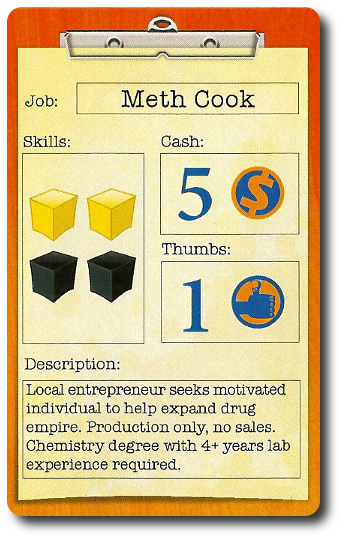



Please note that this game was pulled a little more than 48 hours after its launch. Full details can be found on the project’s update web page. The game publishers are retooling their campaign and expect to be offering Worker Placement to everyone in the near future.